1997 SSANGYONG KORANDO wiring
[x] Cancel search: wiringPage 1632 of 2053
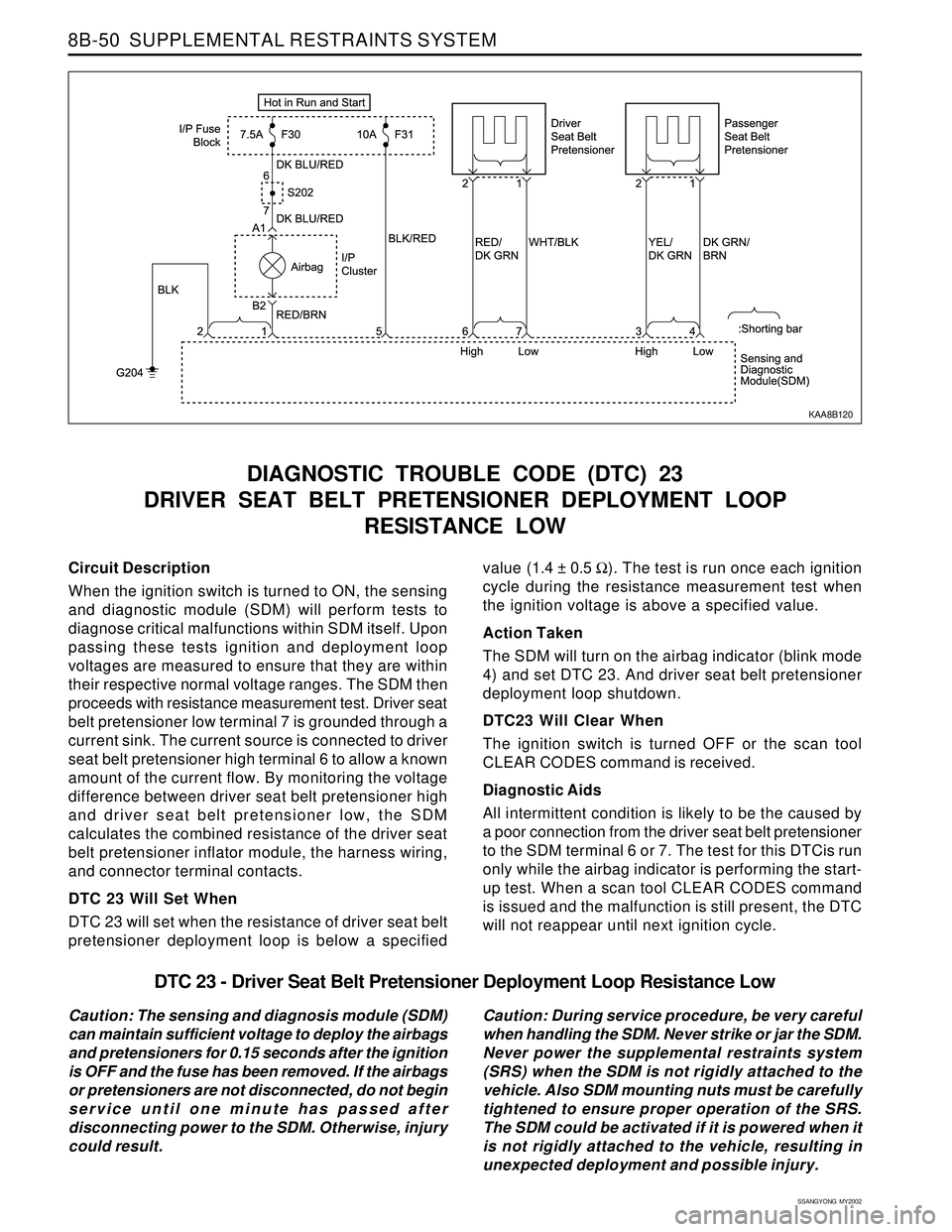
SSANGYONG MY2002
8B-50 SUPPLEMENTAL RESTRAINTS SYSTEM
Circuit Description
When the ignition switch is turned to ON, the sensing
and diagnostic module (SDM) will perform tests to
diagnose critical malfunctions within SDM itself. Upon
passing these tests ignition and deployment loop
voltages are measured to ensure that they are within
their respective normal voltage ranges. The SDM then
proceeds with resistance measurement test. Driver seat
belt pretensioner low terminal 7 is grounded through a
current sink. The current source is connected to driver
seat belt pretensioner high terminal 6 to allow a known
amount of the current flow. By monitoring the voltage
difference between driver seat belt pretensioner high
and driver seat belt pretensioner low, the SDM
calculates the combined resistance of the driver seat
belt pretensioner inflator module, the harness wiring,
and connector terminal contacts.
DTC 23 Will Set When
DTC 23 will set when the resistance of driver seat belt
pretensioner deployment loop is below a specified
DIAGNOSTIC TROUBLE CODE (DTC) 23
DRIVER SEAT BELT PRETENSIONER DEPLOYMENT LOOP
RESISTANCE LOW
value (1.4 ± 0.5 Ω). The test is run once each ignition
cycle during the resistance measurement test when
the ignition voltage is above a specified value.
Action Taken
The SDM will turn on the airbag indicator (blink mode
4) and set DTC 23. And driver seat belt pretensioner
deployment loop shutdown.
DTC23 Will Clear When
The ignition switch is turned OFF or the scan tool
CLEAR CODES command is received.
Diagnostic Aids
All intermittent condition is likely to be the caused by
a poor connection from the driver seat belt pretensioner
to the SDM terminal 6 or 7. The test for this DTCis run
only while the airbag indicator is performing the start-
up test. When a scan tool CLEAR CODES command
is issued and the malfunction is still present, the DTC
will not reappear until next ignition cycle.
KAA8B120
DTC 23 - Driver Seat Belt Pretensioner Deployment Loop Resistance Low
Caution: The sensing and diagnosis module (SDM)
can maintain sufficient voltage to deploy the airbags
and pretensioners for 0.15 seconds after the ignition
is OFF and the fuse has been removed. If the airbags
or pretensioners are not disconnected, do not begin
service until one minute has passed after
disconnecting power to the SDM. Otherwise, injury
could result.Caution: During service procedure, be very careful
when handling the SDM. Never strike or jar the SDM.
Never power the supplemental restraints system
(SRS) when the SDM is not rigidly attached to the
vehicle. Also SDM mounting nuts must be carefully
tightened to ensure proper operation of the SRS.
The SDM could be activated if it is powered when it
is not rigidly attached to the vehicle, resulting in
unexpected deployment and possible injury.
Page 1634 of 2053
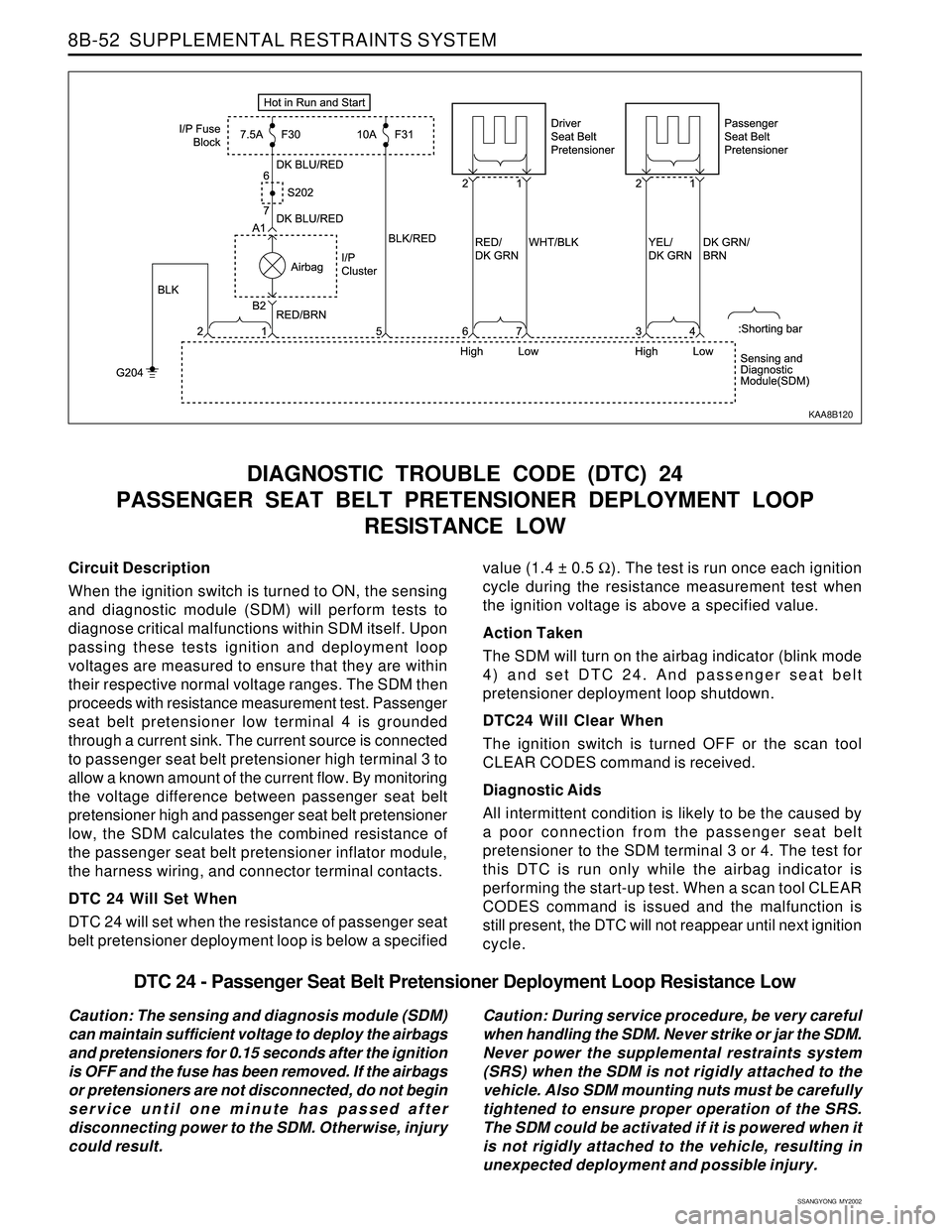
SSANGYONG MY2002
8B-52 SUPPLEMENTAL RESTRAINTS SYSTEM
Circuit Description
When the ignition switch is turned to ON, the sensing
and diagnostic module (SDM) will perform tests to
diagnose critical malfunctions within SDM itself. Upon
passing these tests ignition and deployment loop
voltages are measured to ensure that they are within
their respective normal voltage ranges. The SDM then
proceeds with resistance measurement test. Passenger
seat belt pretensioner low terminal 4 is grounded
through a current sink. The current source is connected
to passenger seat belt pretensioner high terminal 3 to
allow a known amount of the current flow. By monitoring
the voltage difference between passenger seat belt
pretensioner high and passenger seat belt pretensioner
low, the SDM calculates the combined resistance of
the passenger seat belt pretensioner inflator module,
the harness wiring, and connector terminal contacts.
DTC 24 Will Set When
DTC 24 will set when the resistance of passenger seat
belt pretensioner deployment loop is below a specified
DIAGNOSTIC TROUBLE CODE (DTC) 24
PASSENGER SEAT BELT PRETENSIONER DEPLOYMENT LOOP
RESISTANCE LOW
value (1.4 ± 0.5 Ω). The test is run once each ignition
cycle during the resistance measurement test when
the ignition voltage is above a specified value.
Action Taken
The SDM will turn on the airbag indicator (blink mode
4) and set DTC 24. And passenger seat belt
pretensioner deployment loop shutdown.
DTC24 Will Clear When
The ignition switch is turned OFF or the scan tool
CLEAR CODES command is received.
Diagnostic Aids
All intermittent condition is likely to be the caused by
a poor connection from the passenger seat belt
pretensioner to the SDM terminal 3 or 4. The test for
this DTC is run only while the airbag indicator is
performing the start-up test. When a scan tool CLEAR
CODES command is issued and the malfunction is
still present, the DTC will not reappear until next ignition
cycle.
KAA8B120
DTC 24 - Passenger Seat Belt Pretensioner Deployment Loop Resistance Low
Caution: The sensing and diagnosis module (SDM)
can maintain sufficient voltage to deploy the airbags
and pretensioners for 0.15 seconds after the ignition
is OFF and the fuse has been removed. If the airbags
or pretensioners are not disconnected, do not begin
service until one minute has passed after
disconnecting power to the SDM. Otherwise, injury
could result.Caution: During service procedure, be very careful
when handling the SDM. Never strike or jar the SDM.
Never power the supplemental restraints system
(SRS) when the SDM is not rigidly attached to the
vehicle. Also SDM mounting nuts must be carefully
tightened to ensure proper operation of the SRS.
The SDM could be activated if it is powered when it
is not rigidly attached to the vehicle, resulting in
unexpected deployment and possible injury.
Page 1640 of 2053
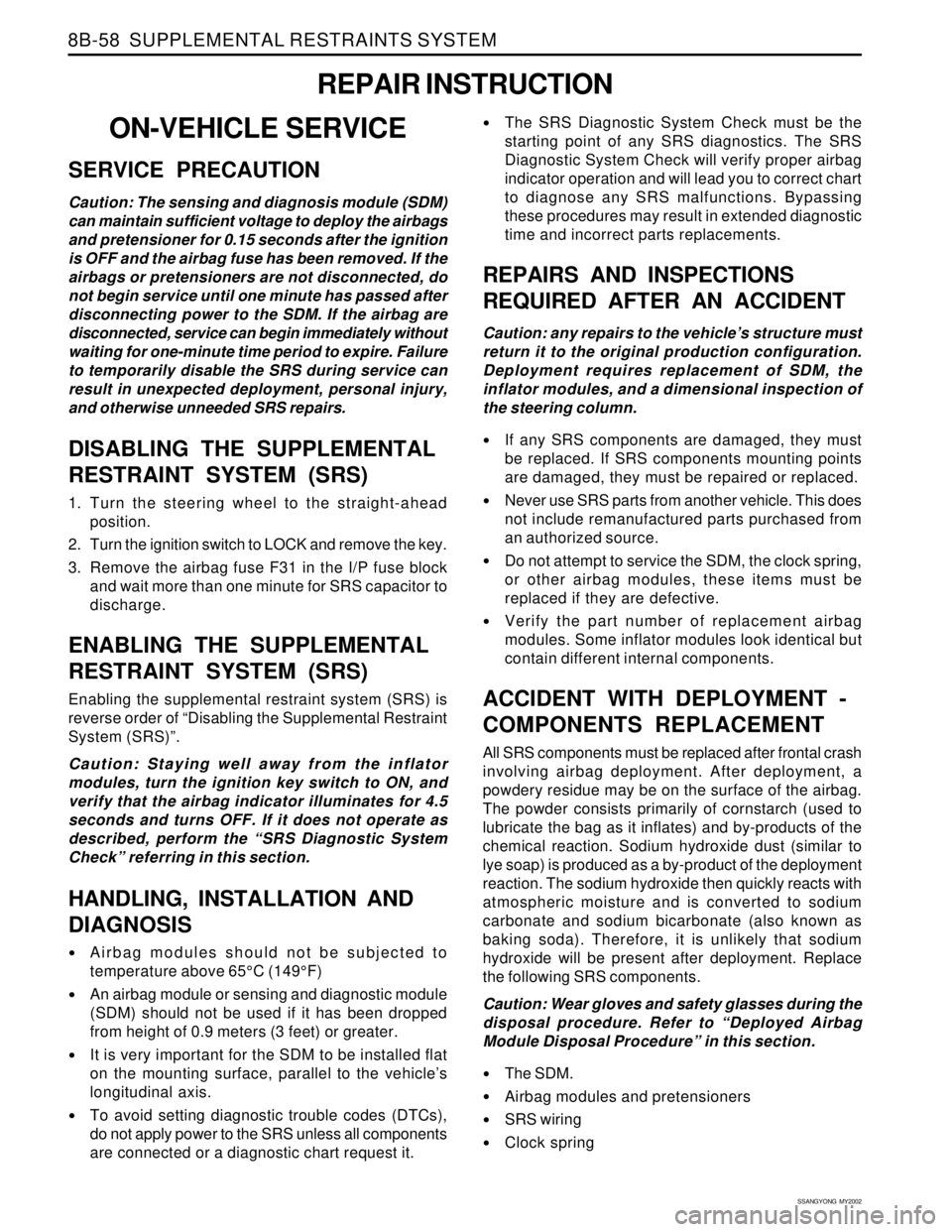
SSANGYONG MY2002
8B-58 SUPPLEMENTAL RESTRAINTS SYSTEM
REPAIR INSTRUCTION
ON-VEHICLE SERVICE
SERVICE PRECAUTION
Caution: The sensing and diagnosis module (SDM)
can maintain sufficient voltage to deploy the airbags
and pretensioner for 0.15 seconds after the ignition
is OFF and the airbag fuse has been removed. If the
airbags or pretensioners are not disconnected, do
not begin service until one minute has passed after
disconnecting power to the SDM. If the airbag are
disconnected, service can begin immediately without
waiting for one-minute time period to expire. Failure
to temporarily disable the SRS during service can
result in unexpected deployment, personal injury,
and otherwise unneeded SRS repairs.
DISABLING THE SUPPLEMENTAL
RESTRAINT SYSTEM (SRS)
1. Turn the steering wheel to the straight-ahead
position.
2. Turn the ignition switch to LOCK and remove the key.
3. Remove the airbag fuse F31 in the I/P fuse block
and wait more than one minute for SRS capacitor to
discharge.
ENABLING THE SUPPLEMENTAL
RESTRAINT SYSTEM (SRS)
Enabling the supplemental restraint system (SRS) is
reverse order of “Disabling the Supplemental Restraint
System (SRS)”.
Caution: Staying well away from the inflator
modules, turn the ignition key switch to ON, and
verify that the airbag indicator illuminates for 4.5
seconds and turns OFF. If it does not operate as
described, perform the “SRS Diagnostic System
Check” referring in this section.
HANDLING, INSTALLATION AND
DIAGNOSIS
Airbag modules should not be subjected to
temperature above 65°C (149°F)
An airbag module or sensing and diagnostic module
(SDM) should not be used if it has been dropped
from height of 0.9 meters (3 feet) or greater.
It is very important for the SDM to be installed flat
on the mounting surface, parallel to the vehicle’s
longitudinal axis.
To avoid setting diagnostic trouble codes (DTCs),
do not apply power to the SRS unless all components
are connected or a diagnostic chart request it.
The SRS Diagnostic System Check must be the
starting point of any SRS diagnostics. The SRS
Diagnostic System Check will verify proper airbag
indicator operation and will lead you to correct chart
to diagnose any SRS malfunctions. Bypassing
these procedures may result in extended diagnostic
time and incorrect parts replacements.
REPAIRS AND INSPECTIONS
REQUIRED AFTER AN ACCIDENT
Caution: any repairs to the vehicle’s structure must
return it to the original production configuration.
Deployment requires replacement of SDM, the
inflator modules, and a dimensional inspection of
the steering column.
If any SRS components are damaged, they must
be replaced. If SRS components mounting points
are damaged, they must be repaired or replaced.
Never use SRS parts from another vehicle. This does
not include remanufactured parts purchased from
an authorized source.
Do not attempt to service the SDM, the clock spring,
or other airbag modules, these items must be
replaced if they are defective.
Verify the part number of replacement airbag
modules. Some inflator modules look identical but
contain different internal components.
ACCIDENT WITH DEPLOYMENT -
COMPONENTS REPLACEMENT
All SRS components must be replaced after frontal crash
involving airbag deployment. After deployment, a
powdery residue may be on the surface of the airbag.
The powder consists primarily of cornstarch (used to
lubricate the bag as it inflates) and by-products of the
chemical reaction. Sodium hydroxide dust (similar to
lye soap) is produced as a by-product of the deployment
reaction. The sodium hydroxide then quickly reacts with
atmospheric moisture and is converted to sodium
carbonate and sodium bicarbonate (also known as
baking soda). Therefore, it is unlikely that sodium
hydroxide will be present after deployment. Replace
the following SRS components.
Caution: Wear gloves and safety glasses during the
disposal procedure. Refer to “Deployed Airbag
Module Disposal Procedure” in this section.
The SDM.
Airbag modules and pretensioners
SRS wiring
Clock spring
Page 1648 of 2053
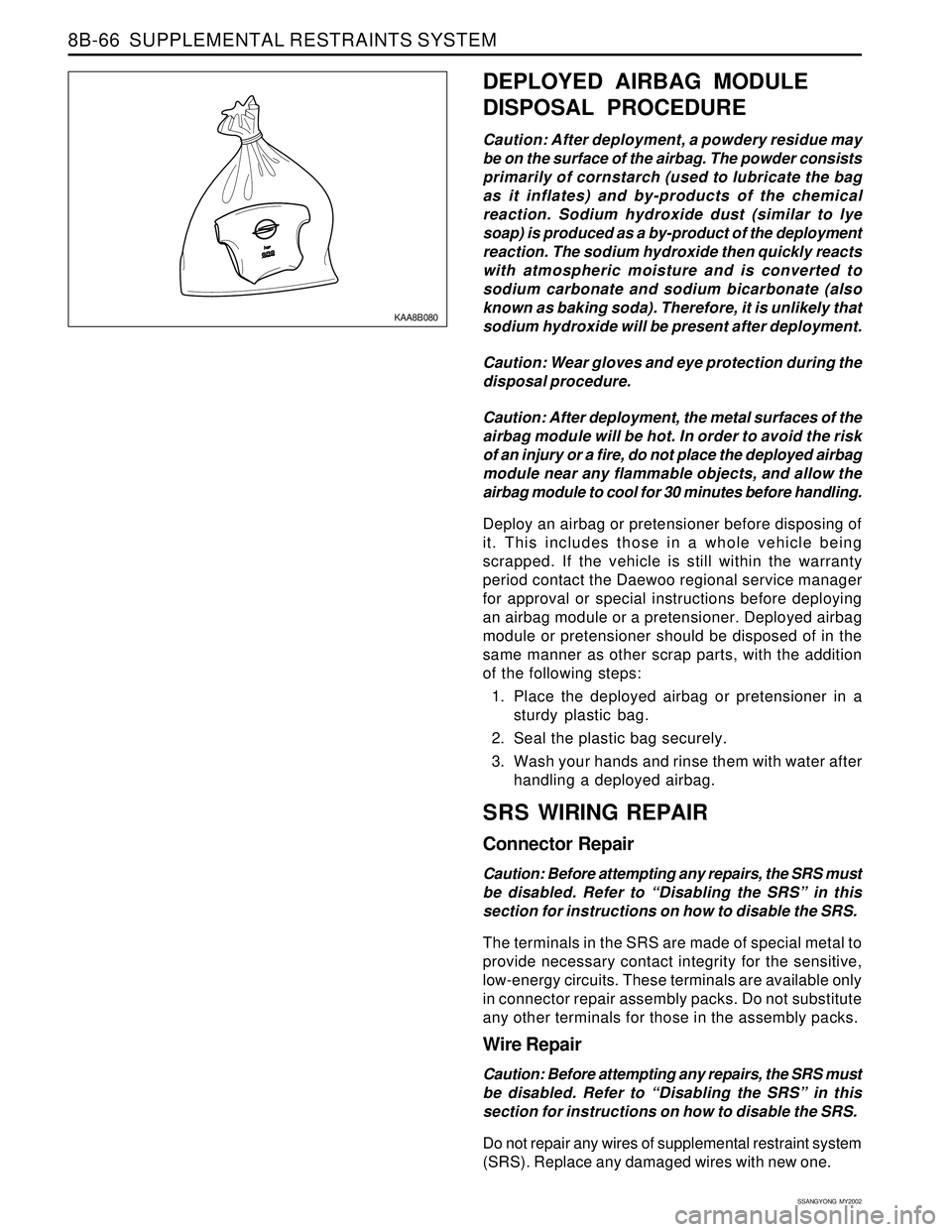
SSANGYONG MY2002
8B-66 SUPPLEMENTAL RESTRAINTS SYSTEM
KAA8B080
DEPLOYED AIRBAG MODULE
DISPOSAL PROCEDURE
Caution: After deployment, a powdery residue may
be on the surface of the airbag. The powder consists
primarily of cornstarch (used to lubricate the bag
as it inflates) and by-products of the chemical
reaction. Sodium hydroxide dust (similar to lye
soap) is produced as a by-product of the deployment
reaction. The sodium hydroxide then quickly reacts
with atmospheric moisture and is converted to
sodium carbonate and sodium bicarbonate (also
known as baking soda). Therefore, it is unlikely that
sodium hydroxide will be present after deployment.
Caution: Wear gloves and eye protection during the
disposal procedure.
Caution: After deployment, the metal surfaces of the
airbag module will be hot. In order to avoid the risk
of an injury or a fire, do not place the deployed airbag
module near any flammable objects, and allow the
airbag module to cool for 30 minutes before handling.
Deploy an airbag or pretensioner before disposing of
it. This includes those in a whole vehicle being
scrapped. If the vehicle is still within the warranty
period contact the Daewoo regional service manager
for approval or special instructions before deploying
an airbag module or a pretensioner. Deployed airbag
module or pretensioner should be disposed of in the
same manner as other scrap parts, with the addition
of the following steps:
1. Place the deployed airbag or pretensioner in a
sturdy plastic bag.
2. Seal the plastic bag securely.
3. Wash your hands and rinse them with water after
handling a deployed airbag.
SRS WIRING REPAIR
Connector Repair
Caution: Before attempting any repairs, the SRS must
be disabled. Refer to “Disabling the SRS” in this
section for instructions on how to disable the SRS.
The terminals in the SRS are made of special metal to
provide necessary contact integrity for the sensitive,
low-energy circuits. These terminals are available only
in connector repair assembly packs. Do not substitute
any other terminals for those in the assembly packs.
Wire Repair
Caution: Before attempting any repairs, the SRS must
be disabled. Refer to “Disabling the SRS” in this
section for instructions on how to disable the SRS.
Do not repair any wires of supplemental restraint system
(SRS). Replace any damaged wires with new one.
Page 1650 of 2053
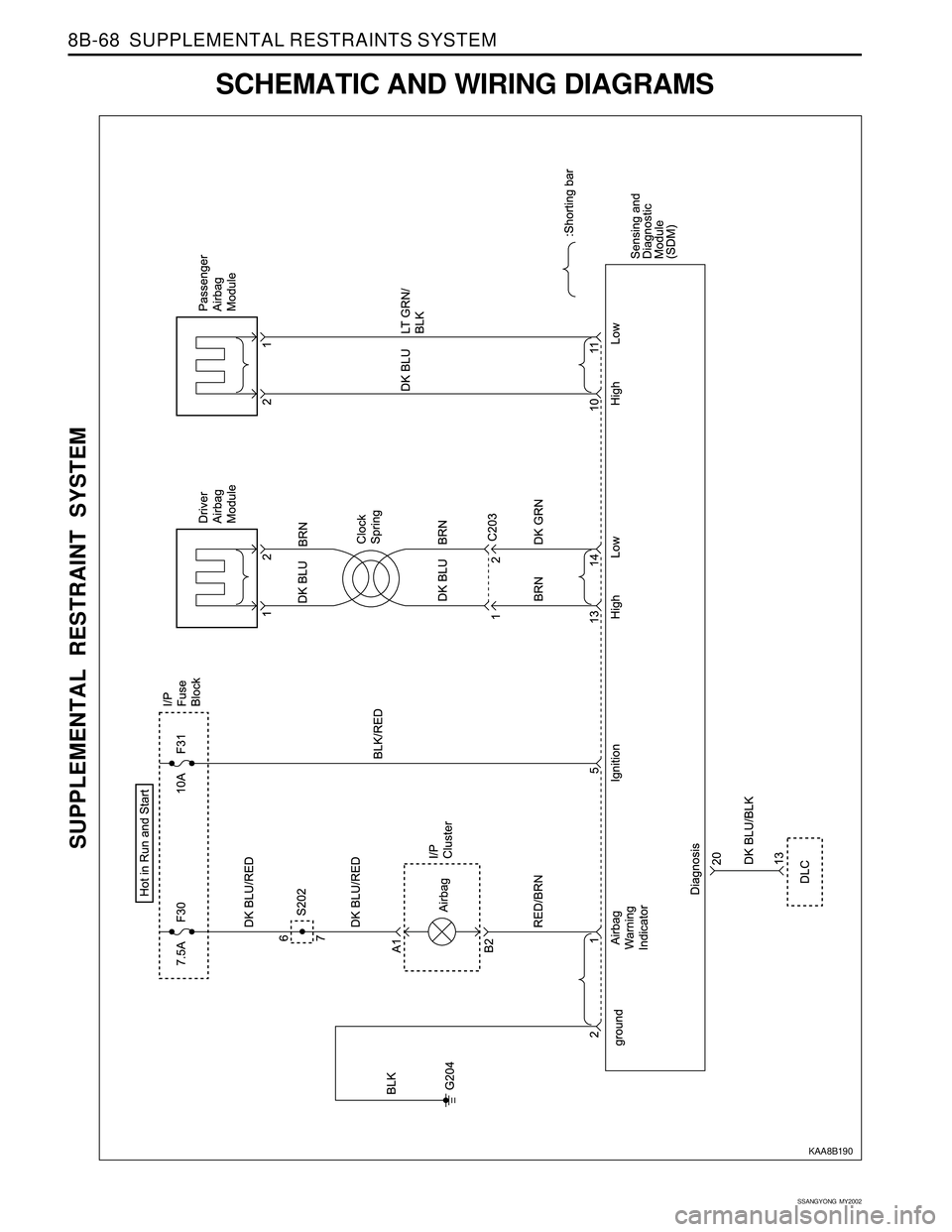
SSANGYONG MY2002
8B-68 SUPPLEMENTAL RESTRAINTS SYSTEM
SCHEMATIC AND WIRING DIAGRAMS
SUPPLEMENTAL RESTRAINT SYSTEM
KAA8B190
Page 1652 of 2053
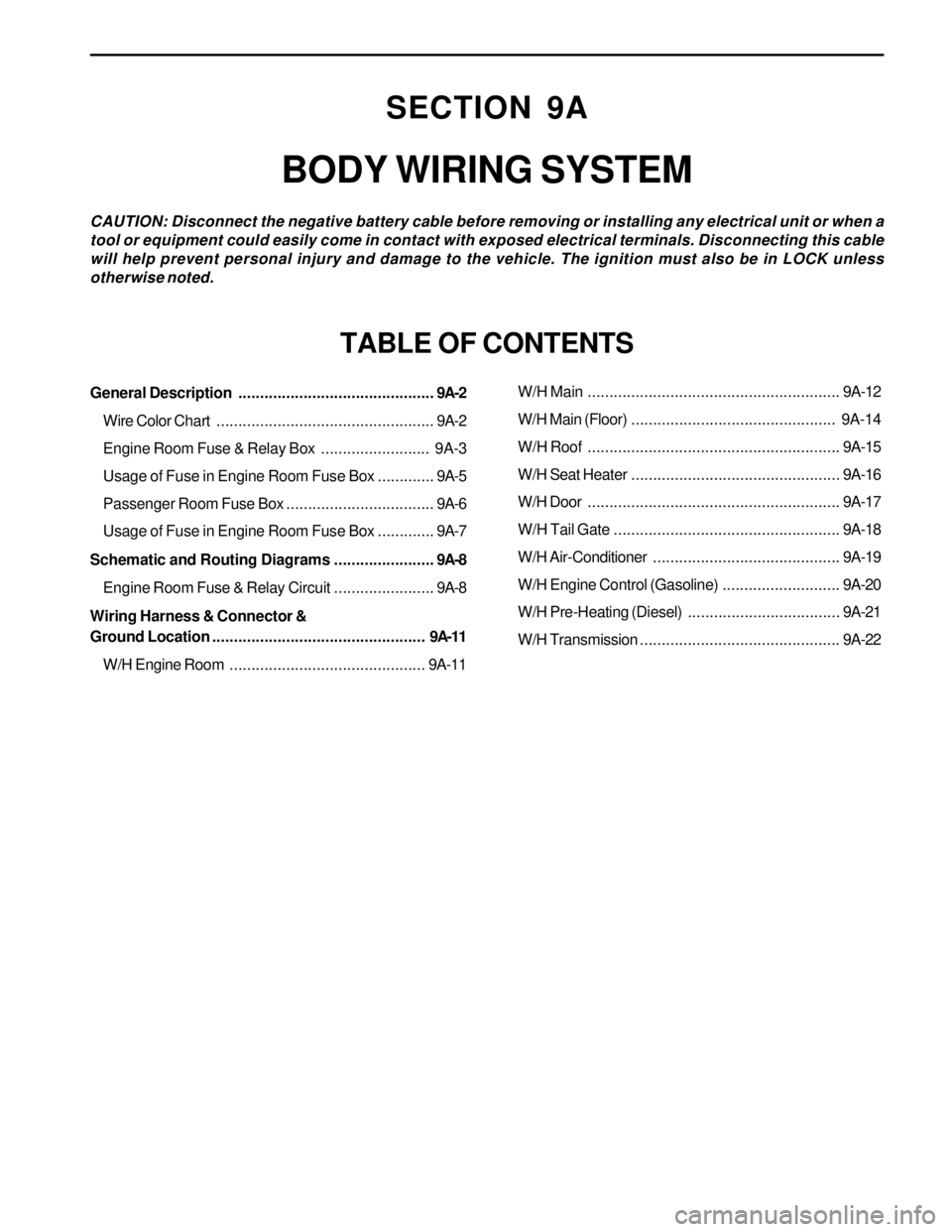
SECTION 9A
BODY WIRING SYSTEM
CAUTION: Disconnect the negative battery cable before removing or installing any electrical unit or when a
tool or equipment could easily come in contact with exposed electrical terminals. Disconnecting this cable
will help prevent personal injury and damage to the vehicle. The ignition must also be in LOCK unless
otherwise noted.
TABLE OF CONTENTS
General Description.............................................9A-2
Wire Color Chart..................................................9A-2
Engine Room Fuse & Relay Box......................... 9A-3
Usage of Fuse in Engine Room Fuse Box.............9A-5
Passenger Room Fuse Box..................................9A-6
Usage of Fuse in Engine Room Fuse Box.............9A-7
Schematic and Routing Diagrams.......................9A-8
Engine Room Fuse & Relay Circuit.......................9A-8
Wiring Harness & Connector &
Ground Location................................................. 9A-11
W/H Engine Room.............................................9A-11W/H Main..........................................................9A-12
W/H Main (Floor)............................................... 9A-14
W/H Roof..........................................................9A-15
W/H Seat Heater................................................9A-16
W/H Door..........................................................9A-17
W/H Tail Gate....................................................9A-18
W/H Air-Conditioner...........................................9A-19
W/H Engine Control (Gasoline)...........................9A-20
W/H Pre-Heating (Diesel)...................................9A-21
W/H Transmission..............................................9A-22
Page 1653 of 2053
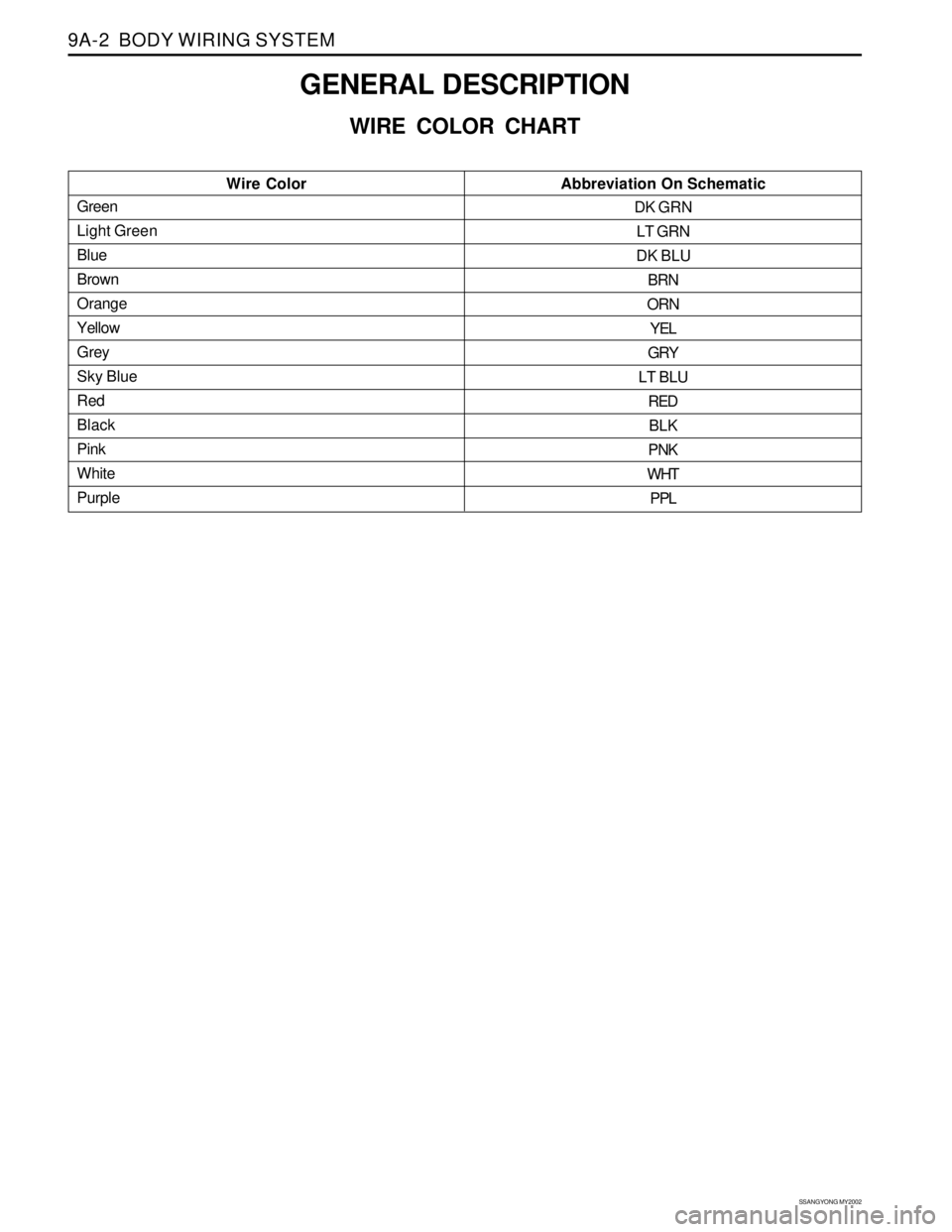
SSANGYONG MY2002
9A-2 BODY WIRING SYSTEM
GENERAL DESCRIPTION
WIRE COLOR CHART
Green
Light Green
Blue
Brown
Orange
Yellow
Grey
Sky Blue
Red
Black
Pink
White
PurpleWire Color Abbreviation On SchematicDK GRN
LT GRN
DK BLU
BRN
ORN
YEL
GRY
LT BLU
RED
BLK
PNK
WHT
PPL
Page 1654 of 2053
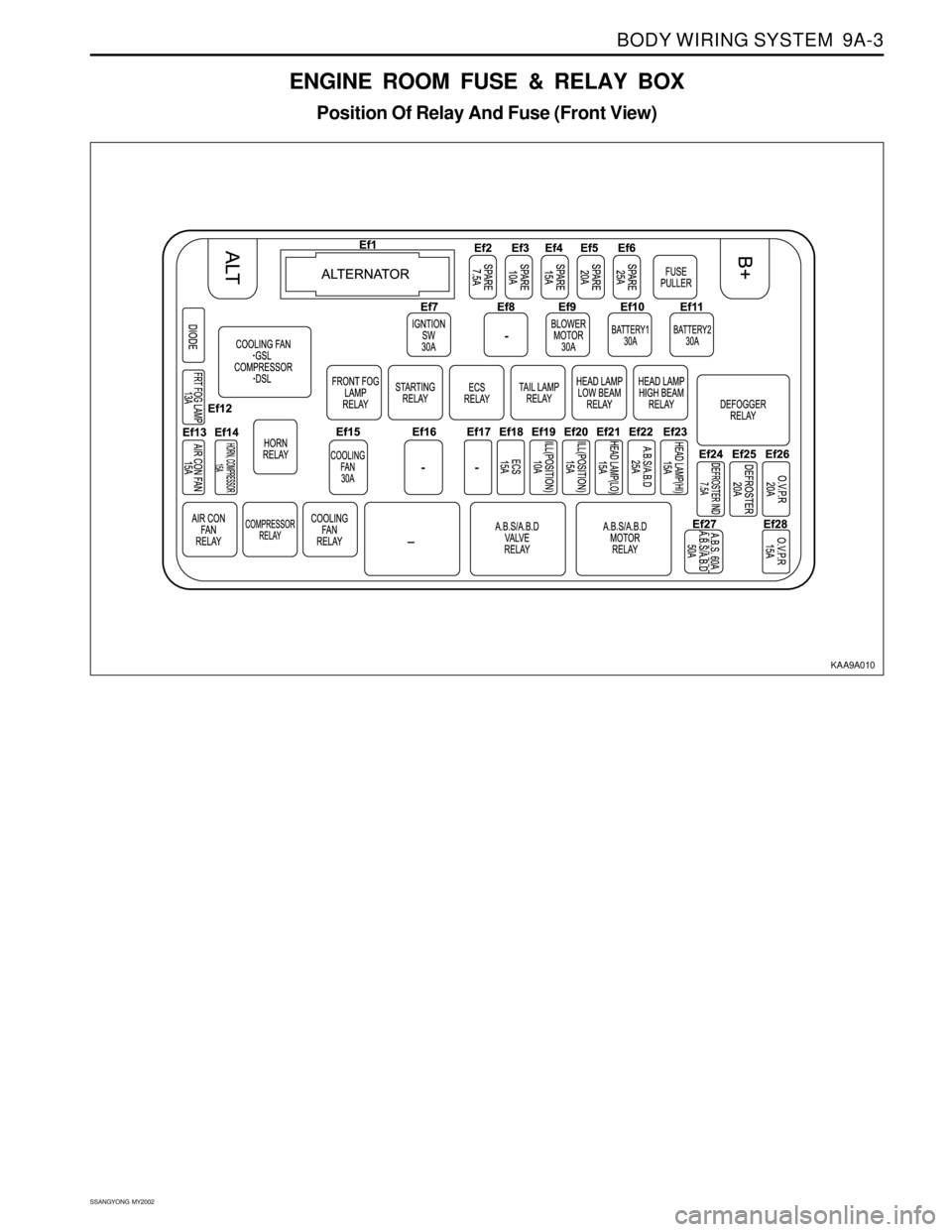
BODY WIRING SYSTEM 9A-3
SSANGYONG MY2002
ENGINE ROOM FUSE & RELAY BOX
Position Of Relay And Fuse (Front View)
KAA9A010